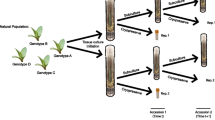Abstract
The use of ex situ techniques for the conservation of threatened plants has been increasing over the past decades. Cryopreservation is often used for the long-term storage of plant germplasm where conventional methods (i.e. seedbanking) are inappropriate. Simple encapsulation–dehydration protocols were developed for the cryopreservation of bryophytes at The Royal Botanic Gardens, Kew, as part of an ex situ project for the conservation of UK threatened species. The applicability of these methods was tested on 22 species with a broad range of ecological requirements and found to be highly successful across the board. Regeneration rates from frozen material were >68% for all species tested and half had regeneration rates of 100%. The high regeneration rate and broad applicability of the protocols across a range of species was attributed to a combination of the inherent totipotency of bryophytes and the in-built recovery periods in the pre-treatment protocol. In conclusion, bryophytes are well suited to cryopreservation and such techniques would be applicable for the long-term storage of similar conservation collections across the globe.


Similar content being viewed by others
References
Benson EE (1999) Cryopreservation. In: Benson EE (ed) Plant conservation biotechnology. Taylor & Francis Ltd, London
Blockeel TL, Long DG (1998) A check-list and census catalogue of British and Irish bryophytes. British Bryological Society, Cardiff
Bunn E, Turner S, Panaia M et al (2007) The contribution of in vitro technology and cryogenic storage to conservation of indigenous plants. Aust J Bot 55(3):345–355. doi:10.1071/BT06065
Burch J (2003) Some mosses survive cryopreservation without prior pretreatment. Bryologist 106(2):270–277. doi:10.1639/0007-2745(2003)106[0270:SMSCWP]2.0.CO;2
Burch J, Wilkinson T (2002) Cryopreservation of protonemata of Ditrichum cornubicum (Paton) comparing the effectiveness of four cryoprotectant pretreatments. Cryo Lett 23(3):197–208
Cochrane JA, Crawford AD, Monks LT (2007) The significance of ex situ seed conservation to reintroduction of threatened plants. Aust J Bot 55(3):356–361. doi:10.1071/BT06173
GonzalezBenito ME, Perez C, Viviani AB (1997) Cryopreservation of nodal explants of an endangered plant species (Centaurium rigualii Esteve) using the encapsulation–dehydration method. Biodivers Conserv 6(4):583–590. doi:10.1023/A:1018337429589
Hill MO, Preston CD, Smith AJE (eds) (1991) Atlas of the bryophytes of Britain and Ireland. Liverworts (Herpaticae and Anthocerotae), vol 1. Harley Books, Colchester
Hill MO, Preston CD, Smith AJE (eds) (1992) Atlas of the bryophytes of Britain and Ireland. Mosses (except Diplolepideae), vol 2. Harley Books, Colchester
Hill MO, Preston CD, Smith AJE (eds) (1994) Atlas of the bryophytes of Britain and Ireland. Mosses (Diplolepideae), vol 3. Harley Books, Colchester
Kim HH, Yoon JW, Park YE et al (2006) Cryopreservation of potato cultivated varieties and wild species: critical factors in droplet vitrification. Cryo Lett 27(4):223–234
Lal M (1984) The culture of bryophytes including apogamy, apospory, parthenogenesis and protoplasts. In: Dyer AF, Duckett JG (eds) The experimental biology of bryophytes. Academic Press, London
Paulet F, Engelmann F, Glaszmann JC (1993) Cryopreservation of apices of in-vitro plantlets of sugarcane (Saccharum Sp hybrids) using encapsulation dehydration. Plant Cell Rep 12(9):525–529. doi:10.1007/BF00236101
Pence VC (1998) Cryopreservation of bryophytes: the effects of abscisic acid and encapsulation dehydration. Bryologist 101(2):278–281
Proctor M (2001) Patterns of desiccation tolerance and recovery in bryophytes. Plant Growth Regul 35(2):147–156. doi:10.1023/A:1014429720821
Ramsay MM, Burch J (2001) Ex situ techniques in support of UK bryophyte conservation. Novitates Botanicae ex Universitatis Carolinae Pragensis 1527–1533
Rowntree JK (2006) Development of novel methods for the initiation of in vitro bryophyte cultures for conservation. Plant Cell Tissue Organ Cult 87(2):191–201. doi:10.1007/s11240-006-9154-7
Rowntree JK, Ramsay MM (2005) Ex situ conservation of bryophytes: progress and potential of a pilot project. Bol Soc Esp Briol 26–27:17–22
Rowntree JK, Duckett JG, Mortimer CL et al (2007) Formation of specialized propagules resistant to desiccation and cryopreservation in the threatened moss Ditrichum plumbicola (Ditrichales, Bryopsida). Ann J Bot 100(3):483–496. doi:10.1093/aob/mcm141
Tanaka D, Niino T, Isuzugawa K et al (2004) Cryopreservation of shoot apices of in-vitro grown gentian plants: comparison of vitrification and encapsulation–vitrification protocols. Cryo Lett 25(3):167–176
UNEP (1992) Convention on biological diversity (CBD) text and annexes. CBD Secretariat, Montreal
UNEP (2002) Global strategy for plant conservation. CBD Secretariat, Montreal
Acknowledgments
We thank Natural England (formally English Nature), Scottish Natural Heritage, Countryside Council for Wales for providing funding for the ex situ project, the lead partners for the UK Biodiversity Action Plans (Countryside Council for Wales, English Nature, Natural History Museum, Plantlife, Royal Botanic Gardens, Kew, Scottish Natural Heritage) for permission to collect and work with these species. Thanks also to RF Preziosi for comments on an earlier draft of the manuscript.
Author information
Authors and Affiliations
Corresponding author
Rights and permissions
About this article
Cite this article
Rowntree, J.K., Ramsay, M.M. How bryophytes came out of the cold: successful cryopreservation of threatened species. Biodivers Conserv 18, 1413–1420 (2009). https://doi.org/10.1007/s10531-008-9453-x
Received:
Accepted:
Published:
Issue Date:
DOI: https://doi.org/10.1007/s10531-008-9453-x




